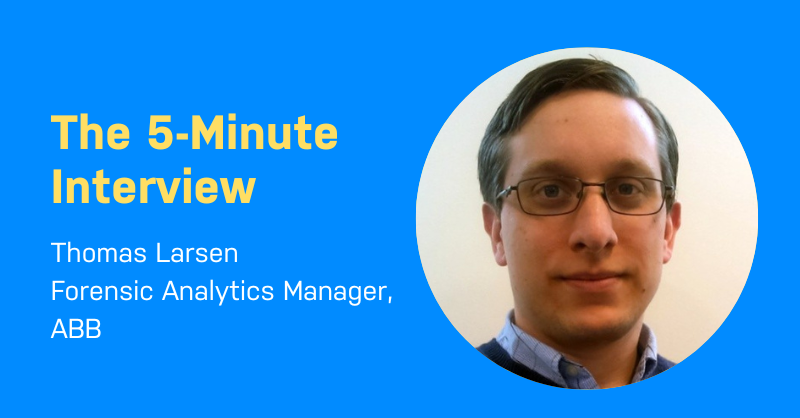Using Graphs to Unlock Forensics: The 5-Minute Interview With Thomas Larsen

Senior Customer Advocacy Manager, Neo4j
3 min read

“What makes me excited about graphs is I don’t know where this can take us. I see a lot of possibilities. In fact, it’s a bit overwhelming knowing where we can go with it,” says Thomas Larsen, Senior Manager of Forensics Analytics at ABB.

We’ve got another 5-Minute Interview for you, folks! This time, we’re showcasing a Neo4j practitioner who uses graph technology in his work with forensics analytics at a global technology company.
Thomas Larsen and his team discovered the power of graph databases when applying it to a simple pilot and watching the magic unfold. This enabled them to find connections that they wouldn’t have been able to find with keywords or a traditional database – certainly a key asset to forensics investigations.
Learn about his experience with Neo4j in his own words below!
Please introduce yourself and tell us about your work.
Thomas Larsen: My name is Tom Larsen. I am a Senior Manager of Forensic Analytics at ABB, which is a large multinational industrial technology company. My role is to do continuous integrity monitoring and provide forensic analytics for investigations.
Why did you choose Neo4j?
Thomas Larsen: I had heard about Neo4j a couple years ago and did not do much with it. A year and a half ago, I hired someone who had Neo4j experience, and I was very interested in the idea of Neo4j and graph databases in general. But that’s not my background, so I didn’t have a good way of implementing it. And with this new hire, he had that experience. And so we came together, and we brainstormed a pilot to try it out and see where it could take us.
What have been the most surprising results you’ve seen from Neo4j?
Thomas Larsen: I’d say some of the most surprising results have been how easy it was to integrate it into our existing mature infrastructure, and then how quickly my team adopted it. I had a team of five, including myself, and all of them now use Neo4j on almost a daily basis. Even one gentleman who’s a bit skeptical of new tools and new technologies – he embraced it. And when he embraced it, I knew we had something special.
What advice do you have for someone just getting started with Neo4j?
Thomas Larsen: I would say, come up with a pilot that’s very simple. Something that you’re already very comfortable with the data – you already know the business processes behind it. And so what you’re really testing is the tool and how that tool can make something better for you.
Our pilot was very simple. We are looking at doing customer and master searches in our systems landscape, and our systems landscape is quite expansive. We have over 30 ERP systems. So Neo4j was our consolidation of those systems into one place where we can easily search for vendors and customers who are potentially subjects of investigations.
And it made that process very simple for us. It’s a one-line, simple Cypher query to do a search, and we’re searching globally. We’re searching across all the systems, and we’re finding connections that we wouldn’t have found through simple keyword searches.
What do you think is in store for the future of graphs?
Thomas Larsen: What makes me excited about graphs is I don’t know where this can take us. I see a lot of possibilities. In fact, it’s a bit overwhelming knowing where we can go with it. We’re already working on our second pilot. It’s an incremental step looking at document flows and SAP and visualizing them and analyzing them better.
For my team being forensics, I’m really excited to start looking into the GDS, the graph data science, part of the world to see where that can help us to be smarter and more intelligent about capturing emerging integrity issues, emerging fraud, and emerging corruption, to make sure that those things don’t happen at ABB.








